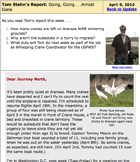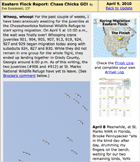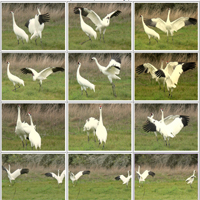Answers Coming April 17!
The "Chass 9" crane-kids began migration April 5, and some Texas whoopers have reached South Dakota! Eight nests with adult pairs incubating have already been found in Wisconsin; calculate a hatch date to circle on your calendar. Dig into our interview with the researcher who banded RAY and YAY and ponder this photo to discover what makes crane eyelids unlike yours.
Today's Report Includes:
- Migration News: Map and Field Reports
- Photo Gallery: Time to Dance
- Journal Topic: Nesting News!
- Research/Interview: Telemetry Project
- Lesson: Tracking the Cranes
- Links: Helpful Resources to Explore
Image of the Week
 Western Flock News |
 Data /Map |
 Eastern Flock News and Finish Line |
|
The northernmost sighting is now in South Dakota! At Aransas NWR, the cranes are going, going...almost gone. What are the remaining cranes up to? When will Tom fly next to count them? |
|
All nine Chass chicks departed April 5! Only two juveniles (#906, #912 at St. Marks) are still in Florida. At least 68 birds have been confirmed back in Wisconsin, and 8 pairs are on nests! See News, finish Line. |
"It
was a thrill of a lifetime to see them dancing. The same evening we
had a good
size bobcat at the Crane House too!"
Sue Kersey
We've been hoping for this announcement, which came from Sara Zimorski, ICF Aviculturist/WCEP Tracking Team and Winter Management Co-chair, who flew an aerial survery on April 5: The exciting news is there are 8 nests already—seven on the Necedah National Wildlife Refuge and one on private lands near the refuge. One of the pairs currently nesting is the wild-hatched chick, #W601 and her mate, #310. The other pairs on nests are: 505 & 415, 303 & 317, 313 & 318 (new nest as of April 5), 213 & 218, 309 & 403, 408 & 519 and 212 & 419 ." Here's this week's question for you:
- If a crane pair started incubating on April 5, on what date will the first egg hatch? Circle the date on your calendar!
- Which pairs have incubated before? Upon what could the outlook for their breeding success depend this year?
In
last week’s slideshow story
you met RAY and YAY, two pioneer Whooping cranes who became the first
cranes
from the western (natural) flock to
fly with GPS devices on their legs. This week we tell you more about this
important research project in an interview with the project manager, Jessica
Rempel. Why is this research happening? What are the goals? How many Whooping
cranes will be banded? How do the GPS devices work? How long will they
last? What will be done with the data? What hurdles had to be overcome
before doing research with an endangered species? What could go wrong?
It’s all here:
Whooping Crane Telemetry Project: Interview With a Researcher
In both the central and eastern flyways, sighting reports by citizen scientists are helping to track migrating cranes as the number of Whooping cranes grows. But the tracking team assigned to the Eastern flock's Class of 2009 also gets help from technology. In Radio Telemetry: Tracking the Cranes ICF's Lara shows you how tracking works. In Signals From the Sky: About Those PTTs, you learn about another tracking method used. Would you like to be a tracker?
- Teachers/Overview: About This Study
- Image of the Week: What is unusual about a Whooping crane's eyes?
- Field Report: Western Flock
- Field Report: Eastern Flock
- Nesting Summary: Chart
- Rowe Sanctuary CraneCam (Nebraska)
- Scientist Interview: Jessica Rempel, Whooping Crane Telemetry Project
- Photo Gallery: Al and Diane Are Dancing
- Nonfiction/Lesson: Radio telemetry: Tracking the Cranes
- Nonfiction/Lesson: Signals from the Sky: About Those PTTs
- Making Good Sightings: Official WCEP Reporting form
- Record Keeping: Arrival Log for Eastern Flock
- Journal: Downloadable Journey North Journal Pages
The Next Whooping Crane Migration Update Will Be Posted on April 16, 2010.






